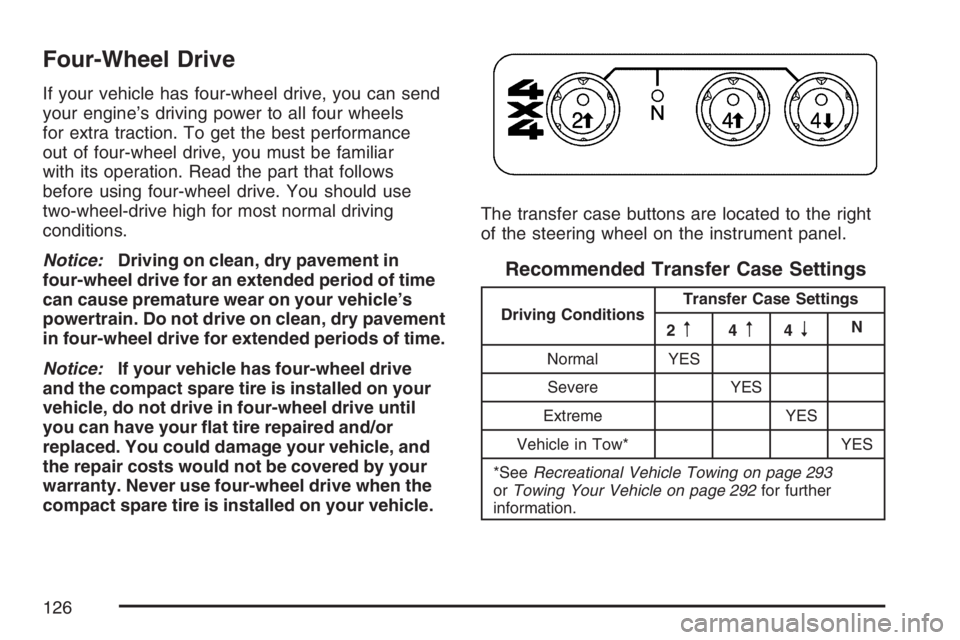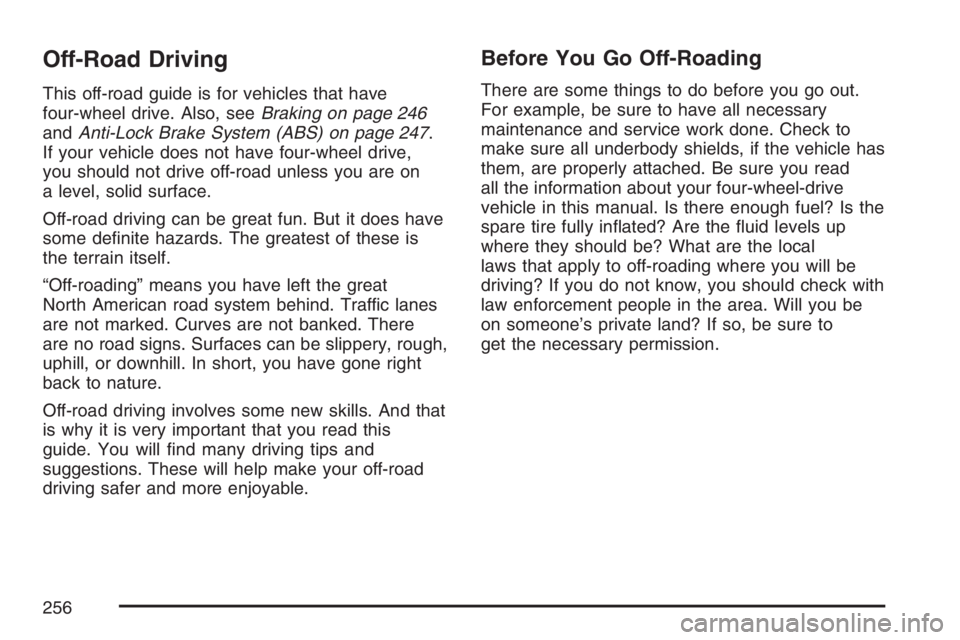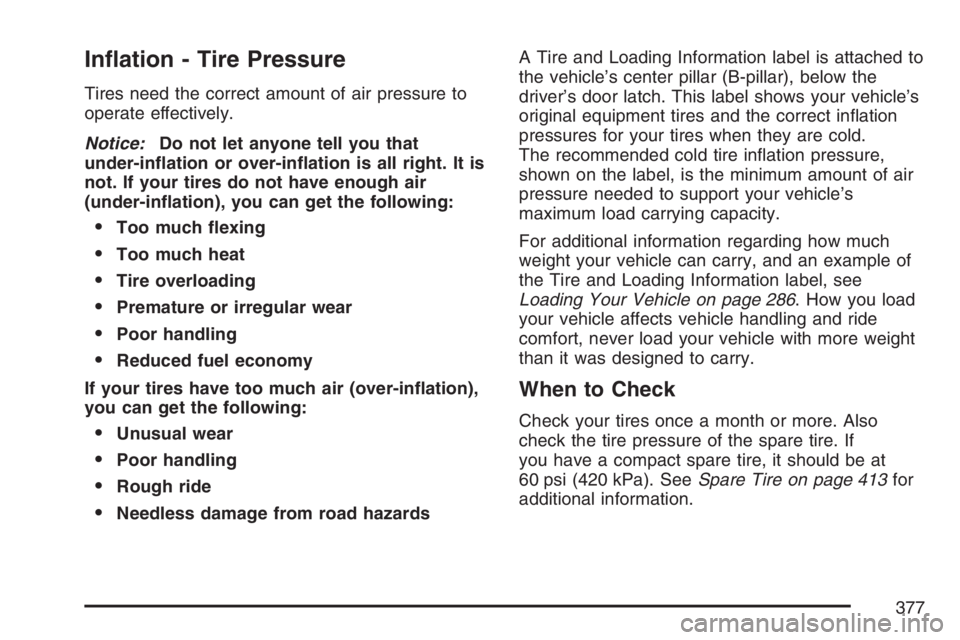2007 GMC CANYON spare tire
[x] Cancel search: spare tirePage 126 of 492

Four-Wheel Drive
If your vehicle has four-wheel drive, you can send
your engine’s driving power to all four wheels
for extra traction. To get the best performance
out of four-wheel drive, you must be familiar
with its operation. Read the part that follows
before using four-wheel drive. You should use
two-wheel-drive high for most normal driving
conditions.
Notice:Driving on clean, dry pavement in
four-wheel drive for an extended period of time
can cause premature wear on your vehicle’s
powertrain. Do not drive on clean, dry pavement
in four-wheel drive for extended periods of time.
Notice:If your vehicle has four-wheel drive
and the compact spare tire is installed on your
vehicle, do not drive in four-wheel drive until
you can have your �at tire repaired and/or
replaced. You could damage your vehicle, and
the repair costs would not be covered by your
warranty. Never use four-wheel drive when the
compact spare tire is installed on your vehicle.The transfer case buttons are located to the right
of the steering wheel on the instrument panel.
Recommended Transfer Case Settings
Driving ConditionsTransfer Case Settings
2m4m4nN
Normal YES
Severe YES
Extreme YES
Vehicle in Tow* YES
*SeeRecreational Vehicle Towing on page 293
orTowing Your Vehicle on page 292for further
information.
126
Page 256 of 492

Off-Road Driving
This off-road guide is for vehicles that have
four-wheel drive. Also, seeBraking on page 246
andAnti-Lock Brake System (ABS) on page 247.
If your vehicle does not have four-wheel drive,
you should not drive off-road unless you are on
a level, solid surface.
Off-road driving can be great fun. But it does have
some de�nite hazards. The greatest of these is
the terrain itself.
“Off-roading” means you have left the great
North American road system behind. Traffic lanes
are not marked. Curves are not banked. There
are no road signs. Surfaces can be slippery, rough,
uphill, or downhill. In short, you have gone right
back to nature.
Off-road driving involves some new skills. And that
is why it is very important that you read this
guide. You will �nd many driving tips and
suggestions. These will help make your off-road
driving safer and more enjoyable.
Before You Go Off-Roading
There are some things to do before you go out.
For example, be sure to have all necessary
maintenance and service work done. Check to
make sure all underbody shields, if the vehicle has
them, are properly attached. Be sure you read
all the information about your four-wheel-drive
vehicle in this manual. Is there enough fuel? Is the
spare tire fully in�ated? Are the �uid levels up
where they should be? What are the local
laws that apply to off-roading where you will be
driving? If you do not know, you should check with
law enforcement people in the area. Will you be
on someone’s private land? If so, be sure to
get the necessary permission.
256
Page 314 of 492

Bulb Replacement....................................... 361
Halogen Bulbs........................................... 361
Headlamps................................................ 362
Front Turn Signal, Parking and
Daytime Running Lamps (DRL).............. 363
Center High-Mounted Stoplamp (CHMSL) ... 364
Taillamps, Turn Signal, Stoplamps and
Back-up Lamps...................................... 364
License Plate Lamp................................... 366
Replacement Bulbs................................... 366
Windshield Wiper Blade Replacement....... 367
Tires............................................................ 369
Tire Sidewall Labeling............................... 370
Tire Terminology and De�nitions............... 374
In�ation - Tire Pressure............................. 377
Tire Pressure Monitor System................... 378
Tire Inspection and Rotation...................... 383
When It Is Time for New Tires.................. 385
Buying New Tires...................................... 386
Different Size Tires and Wheels................ 388
Uniform Tire Quality Grading..................... 389
Wheel Alignment and Tire Balance............ 390
Wheel Replacement.................................. 390Tire Chains............................................... 392
If a Tire Goes Flat.................................... 393
Changing a Flat Tire................................. 394
Removing the Spare Tire and Tools.......... 395
Removing the Flat Tire and
Installing the Spare Tire......................... 398
Secondary Latch System........................... 406
Storing a Flat or Spare Tire and Tools...... 410
Spare Tire................................................. 413
Appearance Care........................................ 415
Cleaning the Inside of Your Vehicle.......... 415
Fabric/Carpet............................................. 416
Leather...................................................... 417
Instrument Panel, Vinyl, and
Other Plastic Surfaces........................... 418
Care of Safety Belts.................................. 418
Weatherstrips............................................ 418
Washing Your Vehicle............................... 419
Cleaning Exterior Lamps/Lenses................ 419
Finish Care............................................... 419
Windshield and Wiper Blades.................... 420
Aluminum or Chrome-Plated Wheels......... 421
Tires......................................................... 422
Section 5 Service and Appearance Care
314
Page 370 of 492

Tire Sidewall Labeling
Useful information about a tire is molded into its
sidewall. The examples below show a typical
passenger vehicle tire and a compact spare tire
sidewall.(A) Tire Size:The tire size is a combination of
letters and numbers used to de�ne a particular
tire’s width, height, aspect ratio, construction type
and service description. See the “Tire Size”
illustration later in this section for more detail.
(B) TPC Spec (Tire Performance Criteria
Speci�cation):Original equipment tires designed
to GM’s speci�c tire performance criteria have
a TPC speci�cation code molded onto the sidewall.
GM’s TPC speci�cations meet or exceed all
federal safety guidelines.
(C) DOT (Department of Transportation):The
Department of Transportation (DOT) code
indicates that the tire is in compliance with the
U.S. Department of Transportation Motor Vehicle
Safety Standards.
(D) Tire Identi�cation Number (TIN):The letters
and numbers following DOT code are the Tire
Identi�cation Number (TIN). The TIN shows
the manufacturer and plant code, tire size, and
date the tire was manufactured. The TIN is molded
onto both sides of the tire, although only one
side may have the date of manufacture.
Passenger Vehicle Tire Example
370
Page 371 of 492

(E) Tire Ply Material:The type of cord and
number of plies in the sidewall and under the tread.
(F) Uniform Tire Quality Grading (UTQG):Tire
manufacturers are required to grade tires
based on three performance factors: treadwear,
traction and temperature resistance. For more
information seeUniform Tire Quality Grading on
page 389.
(G) Maximum Cold In�ation Load Limit:
Maximum load that can be carried and the
maximum pressure needed to support that load.
(A) Temporary Use Only:The compact spare
tire or temporary use tire has a tread life of
approximately 3,000 miles (5 000 km) and should
not be driven at speeds over 65 mph (105 km/h).
The compact spare tire is for emergency use when
a regular road tire has lost air and gone �at.
See “Compact Spare Tire” underSpare Tire on
page 413for additional information.
Compact Spare Tire Example
371
Page 372 of 492

(B) Tire Ply Material:The type of cord and
number of plies in the sidewall and under
the tread.
(C) Tire Identi�cation Number (TIN):The Tire
Identi�cation Number (TIN). The TIN shows
the manufacturer and plant code, tire size, and
date the tire was manufactured. The TIN is molded
onto both sides of the tire, although only one
side may have the date of manufacture.
(D) Maximum Cold In�ation Load Limit:
Maximum load that can be carried and the
maximum pressure needed to support that load.(E) Tire In�ation:The temporary use tire or
compact spare tire should be in�ated to 60 psi
(420 kPa). For more information on tire pressure
and in�ation seeIn�ation - Tire Pressure on
page 377.
(F) Tire Size:A combination of letters and
numbers de�ne a tire’s width, height, aspect ratio,
construction type and service description. The
letter T as the �rst character in the tire size means
the tire is for temporary use only.
(G) TPC Spec (Tire Performance Criteria
Speci�cation):Original equipment tires designed
to GM’s speci�c tire performance criteria have
a TPC speci�cation code molded onto the sidewall.
GM’s TPC speci�cations meet or exceed all
federal safety guidelines.
372
Page 377 of 492

In�ation - Tire Pressure
Tires need the correct amount of air pressure to
operate effectively.
Notice:Do not let anyone tell you that
under-in�ation or over-in�ation is all right. It is
not. If your tires do not have enough air
(under-in�ation), you can get the following:
Too much �exing
Too much heat
Tire overloading
Premature or irregular wear
Poor handling
Reduced fuel economy
If your tires have too much air (over-in�ation),
you can get the following:
Unusual wear
Poor handling
Rough ride
Needless damage from road hazardsA Tire and Loading Information label is attached to
the vehicle’s center pillar (B-pillar), below the
driver’s door latch. This label shows your vehicle’s
original equipment tires and the correct in�ation
pressures for your tires when they are cold.
The recommended cold tire in�ation pressure,
shown on the label, is the minimum amount of air
pressure needed to support your vehicle’s
maximum load carrying capacity.
For additional information regarding how much
weight your vehicle can carry, and an example of
the Tire and Loading Information label, see
Loading Your Vehicle on page 286. How you load
your vehicle affects vehicle handling and ride
comfort, never load your vehicle with more weight
than it was designed to carry.
When to Check
Check your tires once a month or more. Also
check the tire pressure of the spare tire. If
you have a compact spare tire, it should be at
60 psi (420 kPa). SeeSpare Tire on page 413for
additional information.
377
Page 378 of 492

How to Check
Use a good quality pocket-type gage to check tire
pressure. You cannot tell if your tires are
properly in�ated simply by looking at them. Radial
tires may look properly in�ated even when they
are underin�ated. Check the tire’s in�ation
pressure when the tires are cold. Cold means your
vehicle has been sitting for at least three hours
or driven no more than 1 mile (1.6 km).
Remove the valve cap from the tire valve stem.
Press the tire gage �rmly onto the valve to
get a pressure measurement. If the cold tire
in�ation pressure matches the recommended
pressure on the Tire and Loading Information
label, no further adjustment is necessary. If the
in�ation pressure is low, add air until you reach the
recommended amount.
If you over�ll the tire, release air by pushing on
the metal stem in the center of the tire valve.
Recheck the tire pressure with the tire gage.
Be sure to put the valve caps back on the valve
stems. They help prevent leaks by keeping out dirt
and moisture.
Tire Pressure Monitor System
Your vehicle has a Tire Pressure Monitor System
(TPMS). This system uses radio and sensor
technology to check tire pressure levels. TPMS
sensors are mounted onto each tire and wheel
assembly on your vehicle, except the spare tire.
The TPMS sensors monitor the air pressure
in your vehicle’s tires and transmit the tire pressure
readings to a receiver located in the vehicle.
When a low tire pressure condition is detected,
the TPMS will illuminate the low tire pressure
warning light located in the instrument panel
cluster, and at the same time display the LOW
TIRE warning message on the Driver Information
Center (DIC). The low tire pressure warning
light and the LOW TIRE warning message appear
at each ignition cycle until the tires are in�ated
to the correct in�ation pressure.
378